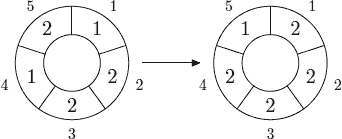| Time Limit: 12000MS | Memory Limit: 65536K | |
| Total Submissions: 3048 | Accepted: 1227 | |
| Case Time Limit: 2000MS | ||
Description
A cellular automaton is a collection of cells on a grid of specified shape that evolves through a number of discrete time steps according to a set of rules that describe the new state of a cell based on the states of neighboring cells. Theorder
of the cellular automaton is the number of cells it contains. Cells of the automaton of order n are numbered from 1 to n.
The order of the cell is the number of different values it may contain. Usually, values of a cell of order m are considered to be integer numbers from 0 to m − 1.
One of the most fundamental properties of a cellular automaton is the type of grid on which it is computed. In this problem we examine the special kind of cellular automaton — circular cellular automaton of order n with cells of orderm.
We will denote such kind of cellular automaton as n,m-automaton.
A distance between cells i and j in n,m-automaton is defined as min(|i − j|, n − |i − j|). A d-environment of a cell is the set of cells at a distance not greater than d.
On each d-step values of all cells are simultaneously replaced by new values. The new value of cell i after d-step is computed as a sum of values of cells belonging to the d-enviroment of the cell i modulo m.
The following picture shows 1-step of the 5,3-automaton.

The problem is to calculate the state of the n,m-automaton after k d-steps.
Input
The first line of the input file contains four integer numbers n, m, d, and k (1 ≤ n ≤ 500, 1 ≤ m ≤ 1 000 000, 0 ≤ d < n⁄2 , 1 ≤ k ≤ 10 000 000). The second
line contains n integer numbers from 0 to m − 1 — initial values of the automaton’s cells.
Output
Output the values of the n,m-automaton’s cells after k d-steps.
Sample Input
sample input #1 5 3 1 1 1 2 2 1 2 sample input #2 5 3 1 10 1 2 2 1 2
Sample Output
sample output #1 2 2 2 2 1 sample output #2 2 0 0 2 2
Source
b =
1 1 0 0 1
1 1 1 0 0
0 1 1 1 0
0 0 1 1 1
1 0 0 1 1
[1, 1, 0, 0, 1]
[1, 1, 1, 0, 0]
[0, 1, 1, 1, 0]
[0, 0, 1, 1, 1]
[1, 0, 0, 1, 1]
b^2 =
[3, 2, 1, 1, 2]
[2, 3, 2, 1, 1]
[1, 2, 3, 2, 1]
[1, 1, 2, 3, 2]
[2, 1, 1, 2, 3]
b^3 =
[7, 6, 4, 4, 6]
[6, 7, 6, 4, 4]
[4, 6, 7, 6, 4]
[4, 4, 6, 7, 6]
[6, 4, 4, 6, 7]
b^4 =
[19, 17, 14, 14, 17]
[17, 19, 17, 14, 14]
[14, 17, 19, 17, 14]
[14, 14, 17, 19, 17]
[17, 14, 14, 17, 19]
/*
ID: wuqi9395@126.com
PROG:
LANG: C++
*/
#include<map>
#include<set>
#include<queue>
#include<stack>
#include<cmath>
#include<cstdio>
#include<vector>
#include<string>
#include<fstream>
#include<cstring>
#include<ctype.h>
#include<iostream>
#include<algorithm>
#define INF (1<<30)
#define PI acos(-1.0)
#define mem(a, b) memset(a, b, sizeof(a))
#define For(i, n) for (int i = 0; i < n; i++)
typedef long long ll;
using namespace std;
const int maxn = 505;
const int maxm = 505;
int mod, n, k, d;
void Matrix_pow(int a[], int b[]) {
ll c[505] = {0};
for (int i = 0; i < n; i++) {
for (int j = 0; j < n; j++) c[i] += ((ll)a[j] * b[(i + j) % n]) % mod;
c[i] %= mod;
}
for (int i = 0; i < n; i++) b[i] = c[i];
}
int a[505], b[505];
int main () {
while(scanf("%d%d%d%d", &n, &mod, &d, &k) != EOF) {
for (int i = 0; i < n; i++) scanf("%d", b + i);
memset(a, 0, sizeof(a));
a[0] = 1;
for (int i = 1; i <= d; i++) a[i] = a[n - i] = 1;
while(k) {
if (k & 1) Matrix_pow(a, b);
k >>= 1;
Matrix_pow(a, a);
}
for (int i = 0; i < n; i++) printf("%d%c", b[i], " \n"[i == n - 1]);
}
return 0;
}
参考:http://www.cppblog.com/varg-vikernes/archive/2011/02/08/139804.html